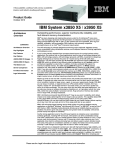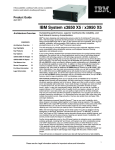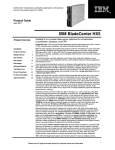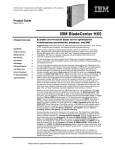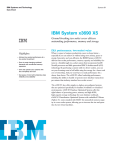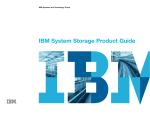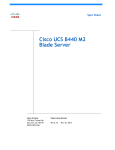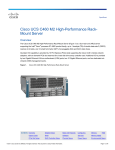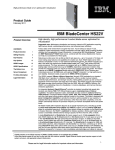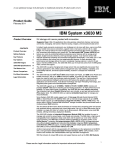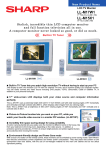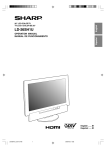Download IBM System x 3690 X5
Transcript
Ultrascalability in a 2-socket package, combined with extreme availability features and industryleading performance ® Product Guide April 2011 IBM System x3690 X5 Architecture Overview Outstanding performance, superior mainframe-like reliability, and fault-tolerant memory characteristics ® CONTENTS Architecture Overview 1 Key Highlights 2 Key Features 3 Key Options 13 x3690 X5 Images 14 x3690 X5 Specs 16 The Bottom Line 19 Server Comparison 21 For More Information 22 Legal Information 22 ® IBM has been designing and implementing servers under the X-Architecture name since 2001. eX5 technology represents the fifth generation of enterprise servers based on the same design principle IBM began with in 1997: to offer systems that are expandable, offer “big iron” reliability, availability, and serviceability (RAS) features, with extremely competitive ® ® price/performance on an Intel Xeon processor-based system. The eX5 technology is primarily designed around three major workloads: database servers, server consolidation using virtualization services, and Enterprise Resource Planning (application and database) servers. If you’re using industry-standard Xeon processor-based servers for running business critical applications, the systems that run these applications need the type of technology designed into IBM’s eX5 technology systems. eX5 technology represents a $100M+ investment in designing a flagship offering that can harness the power of the latest 64-bit x86 (x64) Xeon processors. The eX5 family includes a 2U 2-socket rack-optimized chassis (x3690 X5). In addition, for those workloads that require the maximum available memory, the x3690 X5 support a 1U MAX5 memory expansion unit, which adds an additional 32 DIMM slots (up to 64 DIMMs / 2TB total). You can save money on software licensing by using the memory capacity to virtualize the server into many VMs, rather than using multiple servers. Huge amounts of memory also enable larger VMs and larger databases. The x3690 X5 offers database optimized models with eXFlash solid-state drive technology, pretested and ready to deploy for database workloads. The x3690 X5 Workload Optimized Solution for SAP In-Memory Appliance, SAP HANA models offer a preloaded and optimized appliance based on the two-socket x3690 X5 server platform. These models include two processors, 256GB of memory and choice of all eXFlash SSs or a combination of solid-state and hard disk drives. They are designed for use in small-tomidsized SAP HANA configurations. These models also include the following software: Novell SLES for SAP Applications operating system with three-year priority support and the IBM General Parallel File System (GPFS) with 3 year support. Note: SAP HANA software is included, but sold separately by SAP. The x3690 X5 offers models integrated with a hypervisor preloaded on a USB 2.0 flash key. It operates in a diskless configuration, offers a smaller memory footprint, extremely high performance, and stronger security, making getting a system up and running in a virtualized environment faster and easier than ever before. ™ IBM X-Architecture pioneered XpandOnDemand (“pay as you grow”) scalability, which allows chassis to be simply cabled together to form larger scale-up systems. This capability allows IBM to sell a large SMP (symmetric multiprocessing) system at entry price points. With XpandOnDemand, you can start small and later expand as your needs change, without requiring you to buy more than you need up-front or throw away parts later as you expand. IBM’s eX5 technology-based systems are the ideal solution for scale-up database-serving ® ® ® ® applications on Microsoft Windows with Microsoft SQL Server or IBM DB2 , as well as ® Linux with Oracle or DB2. Database hosting demands ultimate server reliability features, and once installed, they tend to grow and grow, requiring ever greater levels of availability. eX5 servers provide exactly that degree to availability. Another strong application area for the eX5-based systems is enterprise server consolidation activities workloads, including SAP and Oracle. eX5 systems can offer considerable savings ® over UNIX deployments, using our certified solution stacks on either Windows or Linux.. Larger servers need more processor, memory and I/O resources, which make maximum use of any applicable virtual machine software licensing fees and deliver superior system utilization levels. The name of the game in consolidation activities is to deploy the fewest new servers possible and help IT staff manage more images with the same or fewer overall people. The eX5 servers are designed to protect your data with high performance, high reliability, and ® ® high availability. They support the latest ten-, eight-, six-, and four-core Intel Xeon processor E7 family and 7500/6500 series processors, up to 1066MHz memory access, and up Please see the Legal Information section for important notices and information. 1 Ultrascalability in a 2-socket package, combined with extreme availability features and industryleading performance to 30MB of L3 cache to help provide you with the computing power you need to match your business needs and growth. The new Xeon E7-8800, E7-4800, and E7-2800 series processors offer up to 40% greater performance than the previous-generation 7500 and 6500 series processors. ™ In addition, the x3690 X5 uses industry-standard DDR3 memory with Chipkill ECC (Error Checking and Correcting) protection—for high performance and reliability. For even higher ™ levels of availability, the eX5 servers also offer Memory ProteXion , memory scrubbing, memory rank sparing, and selectable memory mirroring. A dual-port integrated high-speed Gigabit Ethernet controller with TOE (TCP Offload Engine) acceleration is standard in all models, as are five high-performance PCIe adapter slots. A 10 Gigabit Ethernet virtual fabric addapter is standard in selected models. The 10GbE solution provides the benefits and flexibility of I/O convergence in a single end-to-end solution. The x3690 X5 offer industry-leading scalability, including up to 1TB of memory in the 2U chassis (upgradeable to 2TB using a 1U MAX5 memory expansion unit), and a choice of up to 16 2.5-inch internal Serial-Attach SCSI (SAS) or Serial ATA II (SATA II) hot-swap hard disk drives, with an internal storage capacity of up to 9.6TB (SAS) or 8TB (SATA), or up to 24 1.8inch solid-state drives (SSDs) with a capacity of 4.8TB. Or, you can combine the two, having 8 HDDs and 16 SSDs in the same chassis. The Standard ServeRAID-M1015 SAS/SATA controller provides RAID-0/1/10 support (upgradeable to 5/50). Optional IBM ServeRAID SAS/SATA/SSD RAID and SSD non-RAID controllers add up to 512MB of battery-backed cache to the onboard controller to provide RAID-0/1/10/10/5/50/6/60. The 2U size of the chassis helps you maximize your rack investments. Up to 21 of these chassis can be installed in a single 42U rack, for a total of up to 42 processors (420 cores), 105 PCIe slots, and 336 HDDs or 504 SSDs, offering an ideal balance of performance, storage and I/O slots per rack. Standard in the x3690 X5 is the Integrated Management Module (IMM) that enables the user to manage and control the server easily—both locally and remotely. The IMM offers a high level of manageability that is designed to keep costs down and the system up—even when network usage increases. The drop-down light path diagnostics panel enables quick servicing of the system if a problem develops. These advanced features help maximize network availability by increasing uptime, as do IBM OnForever™ features, such as hot-swap/redundant HDDs, ™ power and fans; Active Memory ; temperature-controlled fans; IPMI 2.0 support, including highly secure remote power control and Serial over LAN; as well as text- and graphicsconsole redirect over LAN. Another improvement with the new generation of X-Architecture is the replacement of legacy BIOS with a new generation Unified Extensible Firmware Interface (UEFI). UEFI provides a more intuitive user interface and understandable event logs and better management. With the inclusion of unique IBM service and support features such as IBM Systems Director, ™ ™ IBM Systems Director Active Energy Manager , and IBM ServerGuide , the x3690 X5 is designed for maximum uptime. If you need a balance of high-performance two-socket processing, enormous memory expansion, and large I/O capacity in a rack-dense environment, these are the ideal systems. Key Highlights eX5 Design Features eX5 design offers numerous features to boost performance and reduce product and operating costs: 1 • Supports up to two Intel Xeon processors with 12MB to 30MB of L3 cache (processor dependent), and Intel Virtualization Technology (VT) , Hyper-Threading (HT) technology, and Turbo Boost technology. • Supports 10-core, 8-core, or 6-core Xeon E7 family processors or 8-core, 6-core or 4core Xeon 7500 series processors. • Supports up to 1TB of DDR3 memory in a single 2U chassis/node. • The 7147 machine type supports low-voltage 1.35V DIMMs. • Support for a MAX5 memory expansion unit, increasing memory capacity by 100% for memory-intensive workloads. One chassis with a MAX5 supports up to 2TB of memory in 1 3U . • Alternatively, with 64 DIMM slots, the server and MAX5 can be populated with inexpensive 2GB DIMMs (for 128GB), while gaining the performance boost from using 8 memory controllers (4 in the server and four more in the MAX5 unit). • Fast PC3-10600 DDR3 ECC memory with Chipkill error correction, Memory ProteXion (redundant bit steering), memory scrubbing, memory rank sparing, and selectable ™ 7147 machine type; 7148 machine type is limited to 1TB (512GB in the chassis and 512GB in the MAX5).. Please see the Legal Information section for important notices and information. 2 Ultrascalability in a 2-socket package, combined with extreme availability features and industryleading performance memory mirroring protection provides speed and high availability. Key Features • Five high-speed PCIe Gen 2 adapter slots offer investment protection by supporting highperformance adapters, such as 10Gb Ethernet, Fibre Channel, Converged Network ™ Adapter (CNA), and InfiniBand adapters. • The flexibility to configure a 2U or 3U system (using 1 server and 1 MAX5 unit). • 2-Port 10Gb Ethernet virtual fabric adapter and 2-port Gigabit Ethernet controller standard in selected models. • Integrated Management Module (IMM) standard. • Optional ServeRAID controllers that support RAID-0/1/10/5/50/6/60 and high-IOPS SSD drives. • Up to 9.6TB of internal high-speed hot-swap SAS storage, or 8TB of low-cost hot-swap SATA storage, using 16 2.5-inch HDDs; up to 4.8TB of hot-swap solid-state storage, using 24 SSDs. Multicore Xeon Processors The x3690 X5 supports up to two high-performance Intel Xeon E7 family or 7500/6500 series processors (depending on machine type), allowing you to upgrade as business needs require. The system offers a choice of processor clock rates, cache sizes and power draw: Xeon E7 Family Processors • 105W 10-core Xeon processor model E7-8867L running at 2.13GHz, with extremely low power draw per core (10.5W), 6.4 GTps (gigatransfers per second) QPI speed, 1066MHz memory access, dual integrated memory controllers, 30MB of shared L3 cache, and Intel Intel VT, HT, and Turbo Boost technology— processor available via CTO only • 130W 8-core Xeon processor model E7-8837 running at 2.67GHz, with reduced power draw per core (16.25W), 6.4 GTps (gigatransfers per second) QPI speed, 1066MHz memory access, dual integrated memory controllers, 24MB of shared L3 cache, and Intel VT, HT, and Turbo Boost technology • 105W 6-core Xeon processor models E7-4807* running at 1.86GHz, with moderate power draw per core (17.5W), 6.4 GTps (gigatransfers per second) QPI speed, 1066MHz memory access, dual integrated memory controllers, 18MB of shared L3 cache, and Intel Intel VT, and HT technology (no Turbo Boost)— processor available via CTO only • 130W 10-core Xeon processor models E7-2870 running at 2.4GHz, with low power draw per core (13W), 6.4 GTps (gigatransfers per second) QPI speed, 1066MHz memory access, dual integrated memory controllers, 30MB of shared L3 cache, and Intel VT, HT, and Turbo Boost technology • 130W 10-core Xeon processor models E7-2860 or E7-2850 running at 2.26 or 2.0GHz (respectively), with low power draw per core (13W), 6.4 GTps (gigatransfers per second) QPI speed, 1066MHz memory access, dual integrated memory controllers, 24MB of shared L3 cache, and Intel VT, HT, and Turbo Boost technology • 105W 8-core Xeon processor model E7-2830 running at 2.13GHz, with low power draw per core (13.13W), 6.4 GTps (gigatransfers per second) QPI speed, 1066MHz memory access, dual integrated memory controllers, 24MB of shared L3 cache, and Intel VT, HT, and Turbo Boost technology—processor available via CTO only • 105W 8-core Xeon processor models E7-2820 running at 2.0GHz, with low power draw per core (13.13W), 6.4 GTps (gigatransfers per second) QPI speed, 1066MHz memory access, dual integrated memory controllers, 18MB of shared L3 cache, and Intel VT, HT, and Turbo Boost technology • 105W 6-core Xeon processor models E7-2803 running at 1.73GHz, with moderate power draw per core (17.5W), 6.4 GTps (gigatransfers per second) QPI speed, 1066MHz memory access, dual integrated memory controllers, 18MB of shared L3 cache, and Intel VT, and HT technology (no Turbo Boost) Xeon 7500 and 6500 Series Processors • 130W 8-core Xeon processor model X7560 running at 2.26GHz, with low power draw per core (16.25W), 6.4 GTps (gigatransfers per second) QPI speed, 1066MHz memory access, dual integrated memory controllers, 24MB of shared L3 cache, and Intel VT, HT, and Turbo Boost technology • 130W 8-core Xeon processor model X7550 running at 2.0GHz, with low power draw per core (16.25W), 6.4 GTps QPI speed, 1066MHz memory access, dual integrated memory controllers, 18MB of shared L3 cache, and Intel VT, HT, and Turbo Boost technology • 130W 8-core Xeon processor model X6550 running at 2.0GHz, with low power draw per core (16.25W), 6.4 GTps QPI speed, 1066MHz memory access, dual integrated memory Please see the Legal Information section for important notices and information. 3 Ultrascalability in a 2-socket package, combined with extreme availability features and industryleading performance controllers, 18MB of shared L3 cache, and Intel Turbo Boost and Hyper-Threading technology • 95W 8-core Xeon processor model L7555 running at 1.86GHz, with extremely low power draw per core (11.88W), 5.86 GTps QPI speed, 977MHz memory access, dual integrated memory controllers, 24MB of shared L3 cache, and Intel VT, HT, and Turbo Boost technology • 95W 6-core Xeon processor model L7545 running at 1.86GHz, with low power draw per core (15.83W), 5.86 GTps QPI speed, 977MHz memory access, dual integrated memory controllers, 18MB of shared L3 cache, and Intel VT, HT, and Turbo Boost technology • 130W 6-core Xeon processor model L7542 running at 2.66GHz, with reduced power draw per core (21.67W), 5.86 GTps QPI speed, 977MHz memory access, dual integrated memory controllers, 18MB of shared L3 cache, and Intel VT and Turbo Boost technology (no HT) • 105W 6-core Xeon processor model E7540 running at 2.0GHz, with low power draw per core (17.5W), 6.4 GTps QPI speed, 1066MHz memory access, dual integrated memory controllers, 18MB of shared L3 cache, and Intel VT, HT, and Turbo Boost technology • 105W 6-core Xeon processor model E6540 at 2.0GHz, with 64-bit extensions, low power draw per core (17.7W), 5.86 GTps QPI speed, 1066MHz memory access, dual integrated memory controllers, 18MB of shared L3 cache, and Intel Turbo Boost and Hyper-Threading technology • 105W 6-core Xeon processor model E7530 at 1.86GHz, with 64-bit extensions, low power draw per core (17.5W), 5.86 GTps QPI speed, 977MHz memory access, dual integrated memory controllers, 12MB of shared L3 cache, and Intel VT, HT, and Turbo Boost technology • 95W 4-core Xeon processor model E7520 at 1.86GHz, with 64-bit extensions, reduced power draw per core (23.75W), 4.8 GTps QPI speed, 800MHz memory access, dual integrated memory controllers, 12MB of shared L3 cache, and Intel VT and Hyper-Threading technology (no Turbo Boost) • 105W 4-core Xeon processor model E6510* at 1.73GHz, with 64-bit extensions, reduced power draw per core (26.25W), 4.8 GTps QPI speed, 800MHz memory access, dual integrated memory controllers, 12MB of shared L3 cache, and Intel Hyper-Threading technology * This processor is limited to single-chassis memory, without MAX5. With the Xeon E7 family, and 7500/6500 series processors, Intel has diverged from its traditional Symmetric Multiprocessing (SMP) architecture to a Non-Uniform Memory Access (NUMA) architecture. The processors are connected through three serial coherency links called QuickPath Interconnect (QPI). QPI is capable of 6.4 GTps (gigatransfers per second). Put another way, the E7/7500/6500 processors offer 3X the bandwidth of the previous 7400 series processors. Turbo Boost Technology dynamically turns off unused processor cores and increases the clock speed of the cores in use, by up to three model frequencies. For example, with 7-10 cores active, a 2.4GHz E7-2870 10-core processor can run the cores at up to 2.53GHz. With 5-6 cores active, it can run those cores at 2.67GHz; with only 1-4 cores active, it can run those cores at 2.8GHz Similarly, with six cores active, a 2.26GHz X7560 8-core processor can run the cores at 2.53GHz. With only 3-4 cores active, it can run those cores at 2.67GHz. When the cores are needed again, they are dynamically turned back on and the processor frequency is adjusted accordingly. Each processor includes two integrated memory controllers, to reduce memory bottlenecks and improve performance. Memory access is at up to 1066MHz frequency, depending on the processor model and memory used. In processors implementing Hyper-Threading technology, each core has two threads capable of running an independent process. Thus, an 8-core processor can run 16 threads concurrently. Intel’s Virtualization Technology (VT) integrates hardware-level virtualization hooks that allow operating system vendors to better utilize the hardware for virtualization workloads. Intelligent Power Capability powers individual processor elements on and off as needed, to reduce power draw. DDR3 Registered Memory with Active Memory Protection eX5 servers use registered double data rate III (DDR3) DIMMs and provides Active Memory features, including advanced Chipkill memory protection, for up to 16X better error correction than standard ECC memory, IBM Memory ProteXion, and optional memory mirroring or memory rank sparing. In addition to offering triple the memory bandwidth of registered DDR2 or fully-buffered memory, DDR3 memory also uses less energy. 1.8V DDR2 memory already offered up to 37% lower energy use than fully buffered memory. Now, a generation later, Please see the Legal Information section for important notices and information. 4 Ultrascalability in a 2-socket package, combined with extreme availability features and industryleading performance 1.5V DDR3 memory is even more efficient, using 10-15% less energy than DDR2 memory. In addition machine type 7147 supports low-voltage 1.35V DIMMs, which consume up to 19% less energy than 1.5V DIMMs. (1.5V and 1.35V DIMMs can be mixed within a given memory controller, however all DIMMs in that controller will run at 1.5V.) The 7147 machine type of x3690 X5 chassis supports up to 1TB of memory in 32 DIMM sockets using 32GB DIMMs. (The 7148 machine type supports up to 512GB with 16TB DIMMs.) It uses PC3-10600 double data rate 3 (DDR3) memory (operating at 1066MHz) for fast access, as well as PC3-8500 DDR3 and LV versions of both types. Competitive servers may require you to add processors to add memory. eX5 servers with MAX5 decouple memory and processors, so that you can upgrade memory without upgrading to a second processor. The standard configuration supports up to 32 DIMMs. If that is not enough, you can attach a 1U MAX5 memory expansion unit, which adds another 32 DIMM slots (up to 1TB in machine type 7147, for a total of 2TB in only 3U). Redesign in the architecture of the 7500/6500 series and E7 processors bring radical changes in the way memory works in these servers. For example, the processors integrate two memory controllers inside each processor, resulting in four memory controllers in a two-socket system. (MAX5 adds another four memory controllers.) Each controller has two memory channels (four per processor), each with a memory buffer. PCIe Intel Boxboro Intel Xeon E7 Intel Xeon E7 QPI Link MAX5 i The memory architecture of the eX5 chipset provides up to 333% more aggregate memory bandwidth than the previous generation eX4, for exceptional memory performance. By performing reads and writes simultaneously, it eliminates memory read-to-write blocking latency. In addition, it also offers innovative data reliability and security features to help improve data integrity, including enhanced CRC protection, data retry on error detect and buffer registers for improved fault isolation. It is important to ensure that DIMMs with appropriate number of ranks are populated in each channel for optimal performance. Whenever possible, it is recommended to use dual-rank DIMMs in the system. Dual-rank DIMMs offer better interleaving and hence better performance than single-rank DIMMs. Another important guideline is to populate equivalent ranks per channel. For instance, mixing one single-rank DIMM and one dual-rank DIMM in a channel should be avoided. Notes: DIMMs must be installed in matching pairs. Also, each CPU requires at least 2 DIMMs. It is important to ensure that all memory channels in each processor are populated. The relative memory bandwidth decreases as the number of channels populated decreases. This is because Please see the Legal Information section for important notices and information. 5 Ultrascalability in a 2-socket package, combined with extreme availability features and industryleading performance the bandwidth of all the memory channels is utilized to support the capability of the processor. So, as the channels are decreased, the burden to support the requisite bandwidth is increased on the remaining channels, causing them to become a bottleneck. For peak performance: • Populate both processors with equal amounts of memory to enable a balanced NUMA system. • Populate both memory controllers within a processor with equal memory capacity. • Populate an even number of ranks per channel. • Use dual-rank DIMMs whenever appropriate. Power guidelines: • Fewer larger DIMMs (for example 8 x 4GB DIMMs vs. 16 x 2GB DIMMs will generally have lower power requirements • x8 DIMMs (x8 data width of rank) will generally draw less power than equivalently sized x4 DIMMs Reliability guidelines: • Using fewer, larger DIMMs (for example 8 x 4 GB DIMMs vs. 16 x 2GB DIMMs is generally more reliable • Memory controllers support IBM Chipkill memory protection technology with x4 DIMMs (x4 data width of rank) and x8 DIMMs For increased availability beyond Chipkill error correction, the eX5 servers offer additional levels of IBM Active Memory protection: Memory ProteXion technology provides multichip error protection and works in conjunction with Chipkill technology—which provides multibit protection per chip—and standard ECC protection, to provide multi-level memory correction. Memory scrubbing is an automatic daily test of all system memory. It detects and reports memory errors that might be developing before they cause a server outage. Memory scrubbing and Memory ProteXion work together. When a bit error is detected, memory scrubbing determines whether the error is recoverable. If the error is recoverable Memory ProteXion technology will write the data to new location; if it is not recoverable, scrubbing sends an alert to light path diagnostics, which then notifies IBM Systems Director. Memory mirroring works much like disk mirroring. The total memory is divided into two channels, a primary and a backup. Data is written concurrently to both channels. If one of the DIMMs in the primary channel fails, it is instantly disabled and the mirrored memory in the backup channel becomes active (primary) until the failing DIMM is replaced. With mirroring enabled, one-half of total memory is available for use. Alternatively, with memory rank sparing, two ranks per memory card are configured as spares. These spare ranks are used in the event of a memory failure on the same memory card. This feature is more efficient than mirroring, reserving less memory and leaving more available for operating system use. (A memory card using dual-rank DIMMs, for example, would have up to 16 ranks, 14 available.) 2 Memory is available in 1GB, 2GB, 4GB, 8GB, 16GB or 32GB DIMMs . High-Performance Scalability Memory scalability beyond the 1TB capacity of the x3690 X5 chassis is achieved simply by cabling a 1U MAX5 memory expansion unit to the chassis. It doubles memory capacity by adding another 32 DIMMs slots for up to 1TB of additional memory (2TB total in only 3U of rack space). The MAX5 scalability and memory expansion feature is a unique IBM enhancement, not offered by other x86 server architectures. High-Performance Adapter Slots There are five PCIe (PCI Express) Gen 2 adapter slots standard. PCI Express Gen 2 is the latest high-performance, low-latency, next-generation serial I/O bus. Slot 1 is a 3/4-length/fullheight slot. Slot 2 is half-length/full-height. Slots 3 through 5 are low-profile. Slots 1, 2, 3 and 5 are x8 (“by 8”) slots, both physically and electrically (meaning they operate at the full x8 3 8GBps bidirectional speed). Slot 4 is physically x8 but electrically x4, which means it can accept a x8 adapter, but it will operate at x4 speeds (4GBps). If a ServeRAID controller is installed, it will go in Slot 4. If a 10Gb Ethernet Adapter is installed, it will go in Slot 5. If you require a x16 adapter slot, an optional riser card containing one full-length/full-height x16/x16 slot can be added as a replacement for the riser card containing Slots 1 and 2. Please see the Legal Information section for important notices and information. 6 Ultrascalability in a 2-socket package, combined with extreme availability features and industryleading performance Because the dual Gigabit Ethernet, video, and systems management controllers are all integrated onto the system board, four of the five adapter slots are available, which offers you a wide degree of latitude in expansion options. Storage Controllers All models include an integrated IBM ServeRAID-M1015 SAS/SATA Controller. Several other controllers are supported, including: • The 6Gbps (x8 PCIe) ServeRAID-M1015 SAS/SATA controller — RAID-0/1/10 (no cache) for up to 32 drives (limited to available bays). The IBM ServeRAID M1000 Series Advance Feature Key adds RAID-5 and Self-Encrypting Disk (SED) support. • The 6Gbps (x8 PCIe) ServeRAID-M5014 SAS/SATA controller — enhanced performance with 256MB of cache memory, and supports RAID-0/1/10/5/50/6/60 for up to 32 drives (limited to available bays). • The 6Gbps (x8 PCIe) ServeRAID-M5015 SAS/SATA controller — enhanced performance with 512MB of cache memory and battery backup, and supports RAID-0/1/10/5/50/6/60 for up to 32 drives (limited to available bays). • The 6Gbps (x8 PCIe) ServeRAID-M5025 SAS/SATA controller — enhanced performance with 512MB of cache memory and battery backup. It supports RAID-0/1/10/5/50/6/60 for multiple IBM System Storage expansion units (with up to 240 HDDs). • The 6Gbps (x8 PCIe) ServeRAID-B5015 SSD controller — enhanced SSD performance with SSD-optimized microcode, offering the highest IOPS performance for SSDs in a RAID controller. It supports RAID-0/1/5/6 for up to 8 drives. • The IBM 6Gbps SSD HBA offers the highest IOPS performance for SSDs in a non-RAID controller. The ServeRAID M5000 Series Advance Feature Key adds RAID-6/60 with SED support to the M5014 and M5015. The ServeRAID M5000 Series Battery Key adds battery backup support to the M5014. The ServeRAID M5000 Series Performance Accelerator Key adds SSD support to the M5015. Additional external SAS/SATA disk storage, as well as tape backup, is available via one of several supported iSCSI or FC SAN controllers. Drive Bays x3690 X5 servers contain up to 16 HDD bays that support 2.5-inch hot-swap internal SAS/SATA drives totaling up to 9.6TB, or up to 24 solid-state drive bays, supporting 1.8-inch hot-swap SSDs totaling up to 4.8TB, using up to three IBM eXFlash storage options. Each individual SSD is capable of sustaining approximately 4,300 IOPS, which is more than 10X what an enterprise 15,000 RPM 2.5-inch 146.8GB SAS HDD can achieve (420 IOPS). Thus, each eXFlash module (containing 8 SSDs) is capable of producing up to 34,400 IOPS, vs. only 3,360 IOPS for 8 SAS HDDs. This means one x3690 X5, with three eXFlash options (24 drives), is capable of generating 103,200 IOPS, vs. only about 10,000 IOPS for typical storage servers using an equal number of HDDs. Combining 24 SSDs with 2 IBM 640GB High IOPS MLC Duo Adapters produces an astonishing 503,200 IOPS for a single two-socket server. Each customer-installable eXFlash option includes a drive cage, SSD backplane, and two x4 SAS/SATA cables, which can be installed in seconds as a single unit. For RAID support with optimum IOPS, use one ServeRAID-B5015 controller per eXFlash option (or two for even more IOPS). For optimum non-RAID IOPS, use one 6Gbps SSD HBA controller per eXFlash option. 4 (Note: Because SSDs offer triple the reliability of SAS HDDs, RAID support is less necessary.) Each adapter requires a PCIe slot. For maximum IOPS performance, use two ServeRAIDB5015 controllers per eXFlash option (maximum 5, due to available PCIe slots). Supported single-chassis configurations include: • 4 2.5-inch HDDs + 8 1.8-inch SSDs (with 1 eXFlash option) • 8 2.5-inch HDDs + 16 1.8-inch SSDs (with 2 eXFlash options) • 16 2.5-inch HDDs • 24 1.8-inch SSDs (with 3 eXFlash options) • Plus 2 High IOPS adapters (in 2 adapter slots) For RAID support with HDDs, use one ServeRAID-M1015, M5014, or M5015 controller per 8 internal drives, or one ServeRAID-M5025 controller or Fibre Channel adapter per multiple ® external IBM System Storage expansion units (up to 240 drives). An optional (ultraslim, 0.5”) optical drive with a SATA interface is supported in all x3690 X5 servers. An external USB floppy drive or optical drive may be used, if needed. For still more storage, NAS, iSCSI SAN, or FC SAN external expansion options can be added, Please see the Legal Information section for important notices and information. 7 Ultrascalability in a 2-socket package, combined with extreme availability features and industryleading performance using an optional controller. Flexible Internal Storage Capacity The eX5 servers offer a choice of internal storage, supporting up to sixteen high-capacity 2.5inch) hot-swap Serial-Attach SCSI (SAS) or Serial ATA II (SATA II) hard disk drives, or up to 24 high-IOPS 1.8-inch solid-state drives (SSDs) chassis (using three IBM eXFlash options). In addition, two IBM High IOPS SSD adapters can be used per node/chassis. 2.5-inch SAS • 7,200 RPMs — 160, 500GB (8TB maximum) • 10,000 RPMs — 73.4, 146.8, 300, or 600GB (9.6TB) • 15,000 RPMs — 73.4 or 146.8GB (2.38TB) 2-5-inch drives not only require less space than 3.5-inch drives, they weigh less, consume half the power, produce less noise, seek faster, and offer increased reliability. 2.5-inch SATA • 7,200 RPMs — 160 or 500GB (8.0TB) 1.8-inch SSD • 50, 200GB (4.8TB maximum) o High I/O Performance – Offers up to 8X more IOPS than HDDs (67/33% read/write OLTP transaction base mix); – Optimized for heavy mix of read and write operations, such as transaction processing, media streaming, surveillance, file copy, logging, backup / recovery, and business Intelligence o Lower-Cost IOPS Performance – Yields better $/IOPS: lower capacity (GB) required to achieve higher IOPS – Consumes less energy and produces less heat than a conventional disk drive o Superior Uptime – 3X the reliability of mechanical disk drives – No moving parts to fail – Enterprise wear-leveling to extend life even further o Full OS Support ® – Supports all ServerProven OSes For read-intensive transactional workloads requiring extreme IOPS performance, such as database, video-on-demand, and caching, IBM offers High IOPS SSD PCIe Adapters, 5 equivalent to the IOPS output of approximately 500 3.5-inch 600GB 15K SAS HDDs, with 99% lower latency (30 µs), and 7.7x the bandwidth of a HDD. On a performance-per-watt basis, 6 these adapters outperform HDDs by up to 445x . High IOPS SSD PCIe Adapters • IBM 160GB High IOPS SS Class SSD PCIe Adapter (x4 Gen 1—100K IOPS, 750MBps) • IBM 320GB High IOPS SS Class SSD PCIe Adapter (x4 Gen 1—100K IOPS, 750MBps) • IBM 320GB High IOPS MS Class SSD PCIe Adapter (x4 Gen 1—100K IOPS, 750MBps) • IBM 320GB High IOPS SD Class SSD PCIe Adapter (x8 Gen 2—200K IOPS, 1.5GBps) • IBM 640GB High IOPS MLC Duo Adapter (x8 Gen 2—200K IOPS, 1.5GBps) Because these adapters go in PCIe slots, rather than drive bays, they can be used in addition to standard HDDs and SSDs. This makes them ideal for virtualized servers running multiple tasks, requiring both write- and read-intensive storage media. As flash media they also offer a predictable lifetime, compared to the sporadic failure rate of HDDs, using N+1 chip-level redundancy and 11-bit ECC protection. If you need more storage space, terabyte capacities are possible with external direct-attach NAS and SAN solutions. 10 Gigabit Ethernet Virtual Fabric Adapter Selected x3690 X5 models include one dual-port 10Gb Virtual Fabric adapter. (It is optional for all other models.) The Emulex Virtual Fabric Adapter is an industry-leading performance and scalability per watt, dual-port network adapter for 10Gbps Ethernet (10GbE) networks. It offers the benefits and flexibility of I/O convergence in a single end-to-end solution. Protocol offload for stateless TCP/IP and TCP Chimney provide maximum bandwidth with minimum use of CPU Please see the Legal Information section for important notices and information. 8 Ultrascalability in a 2-socket package, combined with extreme availability features and industryleading performance resources. It achieves line rate 10Gbps performance with support for TCP/IP stateless offloads and TCP Offload Engine (TOE) support. TOE reduces system processor utilization, providing increased system performance and reducing overall system power requirements. The adapter is based on the Emulex OneConnect Universal Converged Network Adapter (UCNA) platform that also includes the capability for future upgrades to Fibre Channel over Ethernet (FCoE) and iSCSI protocol offloads. By using a common infrastructure for Ethernet and storage networks, data centers can reduce capital expense (CapEx) for adapters, switches and cables, and operational expense (OpEx) for power, cooling and IT administration. End-to-end data protection with hardware parity, CRC, ECC and other advanced error checking and correcting ensure that data is safe from corruption. Dual 10Gbps Ethernet ports: • IPv4/IPv6 TCP, UDP checksum offload; Large Send Offload (LSO); Large Receive Offload; Receive Side Scaling (RSS); IPV4 TCP Chimney Offload • VLAN insertion and extraction • Jumbo frames up to 9000 Bytes • Preboot eXecutive Environment (PXE) 2.0 network boot support • Interrupt coalescing • Load balancing and failover support including adapter fault tolerance (AFT), switch fault tolerance (SFT), adaptive load balancing (ALB), teaming support and IEEE 802.3ad. Note: You must have either one SFP+ transceiver or one SFP+ direct-attached cable for each of the two 10Gb ports on the adapter. Dual Gigabit Ethernet Controller The eX5 systems include one integrated dual-port Broadcom 5709C Gigabit Ethernet controller, with TOE (TCP Offload Engine) acceleration support, as well as load-balancing and failover capabilities between the two ports. TOE support helps improve overall system performance by offloading TCP/IP protocol processing from the system microprocessor to the onboard Ethernet TOE processor. The controller also supports highly secure remote power management using IPMI 2.0, plus Wake ® on LAN and PXE (Preboot Execution Environment) flash interface. Optional PCI adapters offering failover and load balancing between adapters are available for added throughput and increased system availability. Integrated Virtualization All models of the x3690 X5 support a USB 2.0 Flash Key installed preloaded with VMware vSphere Hypervisor (formerly ESXi). Rather than management through a Service Console based on a Linux operating system, vSphere Hypervisor relies on aggregate management tools, including VirtualCenter, the Remote Command Line interface and the introduction of CIM for standards-based and agentless hardware monitoring. vSphere Hypervisor includes all the performance, scalability and compatibility features of a hypervisor installed on disk, including full VMFS support across FC SAN, iSCSI SAN, and NAS, and 4-way VSMP. Because it runs from flash memory, it’s extremely fast and ideal for diskless configurations. It also offers enhanced security, because it runs without an operating systembased console and is updated/patched much like firmware. Ultra-Efficient Cooling Five strategically located hot-swap/redundant fans, combined with efficient airflow paths, provide highly effective system cooling for the eX5 systems, with N+1 redundancy. The fans automatically adjust speeds in response to changing thermal requirements, depending on the zone, redundancy, and internal temperatures. When the temperature inside the server increases, the fans speed up to maintain the proper ambient temperature. When the temperature returns to a normal operating level, the fans return to their default speed. Why not simply run the fans at 100% capacity all the time? For several good reasons: to reduce the ambient noise, reduce the wear-and-tear on the fans and reduce the server power draw. The reduction in ambient noise and power draw may be relatively minor for a single server, but if you have a larger number of systems the aggregate savings in power and noise pressure can be significant. In addition, the server uses hexagonal ventilation holes in the chassis. Hexagonal holes can be grouped more densely than round holes, providing greater airflow through the system cover. This cooling scheme is important because newer, more powerful processors generate a significant amount of heat, and heat must be controlled for the system to function properly. Please see the Legal Information section for important notices and information. 9 Ultrascalability in a 2-socket package, combined with extreme availability features and industryleading performance Hot-Swap/Redundant Components System availability is maximized through the extensive use of hot-swap and redundant components, including: • Hot-swap redundant hard disk drives and solid-state drives • Hot-swap redundant cooling fans • Hot-swap redundant power supplies Light Path Diagnostics Light path diagnostics enables a technician to quickly identify and locate a failed or failing system component, such as a specific memory DIMM. (Monitored components include processors, memory, power supplies, fans, HDDs, and adapters, plus system temperature.) This enables quick replacement of the component, which helps increase server uptime and lower operating costs. The front of the server has an LED indicator light to show possible component failures. If the front LED indicates an error condition, by pressing a button on the front of the server an LED panel will pop out and drop down for easy viewing without the need to open the server cover or remove the server from the rack. The light path diagnostics panel tells the servicer which component requires attention. In addition, many components have their own identifying LEDs. For example, each of the memory modules has an LED next to the socket, as do all processors, all adapter slots, all fans, all power supplies, all voltage regulator modules and the service processor, allowing the servicer to easily identify exactly which component needs servicing. By following the “light path,” the component can be replaced quickly, and without guesswork. (Note: In the event of a failed DIMM, the system will restart and mark the DIMM as bad while offline, thus allowing the system to continue running, with reduced memory capacity, until serviced.) In addition to the outstanding diagnostic detection, there is a new feature with a digital readout that indicates at what stage of the boot process your system may have experienced trouble. This can reduce the troubleshooting time and help get your system up and running quickly and efficiently. Energy-Smart Features IBM servers work hard to keep your energy bills low—from high-efficiency power supplies and fans to lower-draw processors, memory, and solid-state drives. Technologies such as these, along with the Xeon E7 family and 7500/6500 series processors that intelligently adjust their voltage and frequency, help lower IT costs: • 95W 8-core 7500 series and 6-core E7 family processors use 27% less energy than 130W processors. • 1.5V DDR3 DIMMs consume 10-15% less energy than 1.8V DDR2 DIMMs used in older servers. • 1.35V DDR3 DIMMs consume up to 19% less energy than 1.5V DDR3 DIMMs. • Solid-State Drives consume up to 80% less energy than 2.5-inch HDDs and up to 88% less than 3.5-inch HDDs. • On a performance-per-watt basis, High IOPS SSD Adapters outperform enterprise HDDs by 7 up to 445-to-1 • Dynamic fan speeds — In the event of a fan failure, the other fans will run faster to compensate until the failing fan is replaced. Competitive fans must run faster at all times, just in case, wasting power. Other Features • Trusted Platform Module standard — This module provides a highly secure start-up process from power-on through hand-off to the operating system boot loader. ACPI support is provided to allow ACPI-enabled operating systems to access the security features of this module. (TCG V1.2-compliant.) • Eight USB 2.0 ports — Provides flexibility to add high-speed external devices. The USB 2.0 specification supports up to 480Mbps transfer rates. (Note: Not all USB 2.0 devices are capable of achieving this rate.) Two ports are provided on the front of the server, four are on the back, and two are internal to support an optional flash memory key with embedded hypervisor. • Toolless slides — Allows quick rack installation and quicker upgrade and servicing of the server. • Toolless chassis — The cover can be opened without tools, and many components can be Please see the Legal Information section for important notices and information. 10 Ultrascalability in a 2-socket package, combined with extreme availability features and industryleading performance 8 added or replaced without tools, including processors , DIMMs, hot-swap HDDs, PCIe adapters, an optional optical drive, and the integrated or optional ServeRAID controller. This can save a servicer significant time. Note: The chassis top cover should not be opened during server operation. Opening it will shut the server down. Advanced Systems Management Capabilities The x3690 X5 has a high level of systems management capabilities that are well-suited to remote locations as well as to stand-alone environments. Features include UEFI, IMM with Virtual Media Key, IBM ToolsCenter, IBM Systems Director Active Energy Manager, Automatic ® Server Restart, Wake on LAN support, PXE support, text console redirect, Predictive Failure Analysis, and IBM Systems Director. The IMM provides industry-standard Intelligent Platform Management Interface (IPMI) 2.0compliant systems management. It provides a number of important system functions, including: • Monitoring of system and battery voltage, system temperature, fans, power supplies, processor and DIMM status • Fan speed control • Product ID and Family ID detection • Highly secure remote power on/off • System reset control • NMI/SMI detection and generation • System diagnostic LED control (power, HDD, activity, alerts, heartbeat) • IPMI over LAN • Serial Over LAN • Proxy server support • LAN messaging and alerting • Text console redirection over LAN • Predictive Failure Analysis for system fans • Web-based out-of-band control • SSL (Secure Socket Layer) and LDAP (Lightweight Directory Access Protocol) support • VLAN support • Enhanced authentication and encryption algorithms (RMCP+, AES) • Local update of IMM firmware • Firmware firewall • Support for IPMI v2.0 compliant management software (e.g., xCAT) • Other mandatory and optional IPMI IMM functions The IMM alerts IBM Systems Director to anomalous environmental factors, such as voltage and thermal conditions—even if the server has failed. The x3690 X5 also include standard an IBM Virtual Media Key for additional systems management capabilities, including: • Latest OS failure screen capture • Graphical console redirection over LAN • Remote virtual floppy and CD-ROM • High-speed remote redirection of PCI video, keyboard and mouse IBM ToolsCenter consolidates 42 needed tools for managing servers individually into an integrated suite of 8 tools. They are organized by function: deployment, updates, configuration and diagnostics. Tools are now simpler to access and use with a single webpage for access, a common look and feel and a common command line interface for the scripting tools. The ToolsCenter Bootable Media Creator offers significantly more functionality than past tools with the ability to add more tools to the bootable image and to automatically download the bootable environment if needed. Bootable Media Creator allows you to create bootable CDs, DVD, and USB keys for updates customized to your systems. Automatic Server Restart (ASR) helps reduce downtime by restarting the server automatically in the event of a system lockup. If the operating system crashes or the hardware freezes, it automatically triggers the ASR hardware, which immediately restarts the server (and logs an ASR event with IBM Systems Director). These features are designed so that no more than five minutes can pass before the server is restarted. Wake on LAN permits the server to be remotely powered on if it has been shut off. Once Please see the Legal Information section for important notices and information. 11 Ultrascalability in a 2-socket package, combined with extreme availability features and industryleading performance powered up, the server can be controlled across the network, using the Preboot Execution Environment (PXE). Like Wake on LAN, PXE is system firmware. It enables software such as the optional IBM Remote Deployment Manager to take control of a system before the BIOS, operating system or applications are loaded (using Wake on LAN/PXE) and lets an administrator perform many lowlevel tasks remotely that would otherwise require a visit to each system. These tasks may include such things as formatting a hard disk drive, updating system firmware, or deploying a Windows or Linux operating system. Text and Graphical Console Redirection support allows the administrator to remotely view system text messages and graphics over serial or LAN. Predictive Failure Analysis (PFA) is designed to allow the eX5 servers to detect impending failure of supported components (processors, memory, PCIe slots, power supplies, fans, the XCeL4v Dynamic Server Cache, and hard disk drives) before actual failure, and alert the administrator through IBM Systems Director. This gives you the ability to replace the failing component before it fails, resulting in increased uptime. IBM Systems Director software for advanced workgroup management is included standard. IBM Systems Director comes with a portfolio of tools, including IBM Systems Director Active Energy Manager, Service and Support Manager, and others. System Availability (a no-charge download) and Capacity Manager (sold separately) are available as add-ons for additional server management and increased availability. IBM Systems Director provides a single uniform graphical interface for all of these systems management functions. IBM Systems Director enables you to customize thresholds and monitor system components (for things like temperature, voltage regulation, etc.) to help maximize uptime. IBM developed IBM Systems Director Active Energy Manager to put control of system powersaving features at the fingertips of administrators. Active Energy Manager is designed to take advantage of new features, such as monitoring power usage and balancing the performance of the system according to available power input. It provides the ability to plan and predict power consumption based on your hardware configuration. It also helps enable you to reduce the infrastructure required for redundancy, by using fewer servers on smaller power feeds and potentially lowering your overall data center support costs. It does this by inventorying all components, then adding up the total power draw and tracking the usage. It also includes power management features to help administrators manage or reduce power usage. Extensive System Support Features The IBM services and technical support portfolio provides world-class, consistent, high-quality service and support. The eX5 servers offer a number of tools and services designed to make ownership a positive experience. From the start, IBM programs make it easier for you to plan for, configure and purchase System servers, get them running and keep them running long-term. These features include IBM ServerProven, the IBM Standalone Solutions Configuration Tool, IBM System x and BladeCenter Power Configurator, IBM ServerGuide, IBM Systems Director Service and Support Manager, Product Customization Services and extensive technical support offerings. The IBM ServerProven program provides the confidence that specific options and operating systems have been tested on the server and are officially supported to work together. It is updated frequently to ensure that the latest compatibility information is always at your fingertips. The IBM Standalone Solutions Configuration Tool (SSCT) is a downloadable tool that simplifies the often complex chore of configuring a full rack of servers (including blade servers) and confirming that you have all the cables, power distribution units, KVM (keyboard, video and mouse) switch boxes and other components you need, as well as the proper airflow clearances, electrical circuits and other environmental conditions. IBM System x and BladeCenter Power Configurator helps IT managers plan for data center power needs, by providing the following information for specific configurations of System x and BladeCenter systems: power input (watts), PDU sizing (amps), heat output (BTUs), airflow requirements through chassis (CFM), VA rating, leakage current (mA), and peak inrush current (amps). IBM ServerGuide (installed from CD) simplifies the process of installing and configuring System x and BladeCenter servers. ServerGuide goes beyond mere hardware configuration by assisting ® ® with the automated installation of the Microsoft Windows Server 2008 operating systems, device drivers and other system components, with minimal user intervention. (Drivers are also included for support of Novell NetWare, Red Hat Linux and SUSE LINUX.) This focus on deployment helps you reduce both your total cost of ownership and the complexity that administrators and technical personnel face. IBM Systems Director Service and Support Manager (previously called IBM Electronic ™ Service Agent ) is an innovative “call home” feature that allows System x and BladeCenter servers to automatically report hardware problems to IBM support, which can even dispatch Please see the Legal Information section for important notices and information. 12 Ultrascalability in a 2-socket package, combined with extreme availability features and industryleading performance onsite service if necessary to those customers entitled to onsite support under the terms of their warranty or an IBM Maintenance Agreement. Service and Support Manager resides on a server and provides electronic support and problem management capabilities through a highly secure electronic dialogue between your systems and IBM. It monitors networked servers for hardware errors and it can perform hardware and software inventories and report inventory changes to IBM. All information sent to IBM is stored in a highly secure database and used for improved problem determination. Additional services include hardware warranty upgrades and factory-installed Product Customization Services (PCS), such as asset tagging, hardware integration, software imaging and operating systems personalization. IBM offers extensive industry-leading technical support by phone and via the Web. Support options include links to forums/newsgroups, problem submission, online shopping support, service offerings, device drivers for all IBM product lines, software downloads and even upcoming technical seminar worldwide schedules and registration. Also available are remote installation, configuration and usage support for System x hardware and software, as well as onsite custom services to provide the level of expertise you require. IBM Maintenance and Technical Support solutions can help you get the most out of your IT investment by reducing support costs, increasing availability and simplifying management with integrated support for your multiproduct, multivendor hardware and software environment. For more information on hardware maintenance, software support, solution support and managed support, visit http://ibm.com/services/maintenance. Key Options IBM options for System x servers help you take your servers to a higher level You can rely on System x options to supply a complete solution for your business needs. Options help you create an optimized server system to meet your data protection, storage and availability needs. Every IBM option is designed and tested for peak performance and flexibility, helping to maximize your return on investment. The combination of System x servers and options lets you keep your fingers on the pulse of your e-business. Processors — The Intel Xeon processors provide high clock rates, a choice of 10, 8, 6, or 4 cores, a large L3 cache and advanced features for availability and manageability (processorspecific). Large cache size, combined with fast 1066MHz memory access, reduces memory latency and facilitates the movement of data through the processor and I/O devices. (Note: System performance depends not only on the number of processors in the server but also on the power and functionality of each processor.) Adding a second processor may be a cost-effective way to achieve significant performance improvements. Memory — Memory is a significant factor in systems application performance. Adding more memory to a System x server is one of the most effective ways to increase application performance. For optimum performance, an 8-core processor should have twice as much memory as a 4-core processor. x3690 X5 servers support 32 DIMMs natively and 64 DIMMs using a MAX5 memory expansion unit. 1.35V DIMMs (machine type 7147) can help reduce energy consumption by up to 19%. Hard Disk Drives — IBM hard disk drives help customers improve the transaction and cost performance of their System x servers. The choice of hard disk drives can be a critical aspect of maximizing the I/O throughput of the system. SAS hard disk drives (2.5-inch) are available for the eX5 servers with capacities of 500GB at 7,200 RPMs, up to 600GB at 10,000 RPMs, and 146.8GB at 15,000 RPMs. Enterprise-class 2.5-inch SATA hard disk drives are available with capacities of up to 500GB at 7,200 RPMs. Solid State Drives — IBM offers a choice of 50GB or 200GB 1.8” solid-state drives as a higher reliability, lower-energy-use, higher-IOPS alternative to internal HDDs. They can be used as a highly available boot drive, for storing disk images, or for other uses that stress read performance, such as databases. High IOPS SSD PCIe Adapters — For storage media offering up to 500 times the I/O operations per second (IOPS) and up to 7.7 times the bandwidth of 15,000-RPM HDDs, IBM offers the 160GB High IOPS SS Class SSD PCIe Adapter, the 320GB High IOPS SS Class SSD PCIe Adapter, the 320GB High IOPS MS Class SSD PCIe Adapter, and the 320GB High IOPS SD Class SSD PCIe Adapter, as well as the 640GB High IOPS MLC Duo Adapter. These adapters offer near-DRAM performance, with extremely high data retention (up to 25 years) and RAID-grade data protection, and can be used in addition to HDDs and SSDs. IBM ServeRAID Controllers — System x servers using ServeRAID technology allow companies to build a reliable foundation for business-critical computing. IBM ServeRAID technology allows an array consisting of multiple physical hard disk drives to be treated as one logical drive. ServeRAID technology also allows data to be stored redundantly, across multiple hard disk drives— enhancing both the integrity and the availability of the data. SAS and SATA ServeRAID controllers offer enhanced performance due to onboard processors and cache. Because IBM Please see the Legal Information section for important notices and information. 13 Ultrascalability in a 2-socket package, combined with extreme availability features and industryleading performance ServeRAID controllers can help significantly improve data transfer rates, this technology is extremely effective when implementing demanding, transaction-oriented applications. By employing the advanced fault tolerance of IBM ServeRAID technology, companies can effectively implement networked business systems that require large amounts of storage space for data and applications that must be available for their businesses to continue operating. Supported SAS/SATA RAID controllers include the IBM ServeRAID-M1015 (x8 PCIe, RAID0/1/10), IBM ServeRAID-M5014 (x8 PCIe, 256MB cache, RAID-0/1/10/5/6; optional battery backup, RAID-50/60 and SED), IBM ServeRAID-M5015 (x8 PCIe, 512MB cache, battery backup, RAID-0/1/10/5/6; optional RAID-50/60 and SED) and the IBM ServeRAID-M5025 (x8 PCIe, 512MB cache, battery backup, RAID-0/1/10/5/6; optional RAID-50/60 and SED; supports multiple external IBM System Storage expansion units). The ServeRAID-B5015 controller is optimized for high-IOPS RAID performance with SSDs. The IBM 6Gbps SSD HBA is optimized for high-IOPS non-RAID performance. External Storage — The IBM System Storage EXP810, EXP3512 and EXP3524 expansion units, as well as the DS3000, DS4000, DS5000, DS8000 series, and XIV storage subsystems and N3000, N5000, N6000, and N7000 NAS systems, comprise a powerful and broad shared storage family with integrated management software designed to meet midrange and enterprise ® needs. In addition, IBM Storwize V7000 is virtual storage that offers high efficiency and flexibility through built-in SSD optimization and “thin provisioning” technologies. x3690 X5 Images Front View Hot-Swap HDD Bays Power Button Video Port USB Ports Hexagonal Ventilation Holes Pop-Out Light Path Diagnostics Panel Optical Drive Light Path Diagnostics Panel Eject Button Rack Release Button Rear View Hexagonal Ventilation Holes PCIe Slots 1&2 PCIe Slots 3&4 PCIe Slot 5 Scalability Video Serial Ports Port Port Systems Management Gb Ethernet Port USB Ports Gb Ethernet Ports Redundant H/S Power Supply Bays Please see the Legal Information section for important notices and information. 14 Ultrascalability in a 2-socket package, combined with extreme availability features and industryleading performance Interior View 2 Processors 5 Hot-Swap Fans 2 PCIe Adapter Slots 2 PCIe Adapter Slots 1 PCIe Adapter Slot Internal USB Slot 4 Hot-Swap Power Supply Bays 16 DIMM Slots Optical Drive an Up to 16 HDD or 24 SSD Bays Redundant Power Interposer MAX5 Interior View 2 Hot-Swap Redundant Power Supply Bays (Removed) 16 DIMM Slots 16 DIMM Slots 5 HotSwap Fans Please see the Legal Information section for important notices and information. 15 Ultrascalability in a 2-socket package, combined with extreme availability features and industryleading performance x3690 X5 Specifications Machine type 7147-A1x/A2x/A3x/A5x/A6x/A7x, C1x, D1x/D2x. H2x/H3x 7148-1Rx, 2Dx/2Rx, 3Dx/3Gx/3Rx/3Sx, 4Rx/4Sx, ARx Form factor (standard/maximum) 2U / 3U (1 2U chassis + 1 1U MAX5 memory expansion unit) Processor type Ten-core Xeon (E7-28xx, E7-88xx) 2.0GHz E7-2850 (A5x), 2.13GHz E78867L (CTO), 2.26GHz E7-2860 (A6x, D1x/D2x), 2.4GHz E7-2870 (A7x, H3x/H3x), 2.67GHz E7-8837 (C1x) Eight-core Xeon (E7-28xx/X65xx/ X75xx) 2.0GHz X6550 (3Dx/3Gx/3Rx), 2.0GHz X7550 (3Sx), 2.0GHz E72820 (A2x), 2.13GHz E7-2830 (A3x), 2.26GHz X7560 (4Rx/4Sx) Six-core Xeon (E7-28xx/E748xx/E65xx) 1.73GHz E7-2807 (A1x), 1.86GHz E74807 (CTO), 2.0GHz E6540 (2Dx/2Rx) Four-core Xeon (E75xx) 1.86GHz E7520 (1Rx, ARx) Processor cores 20 (A5x/A6x/A7x, C1x, plus E7-8867L, via CTO) 16 (3Dx/3Gx/3Rx/3Sx, 4Rx/4Sx, A2x/A3x) 12 (2Rx, A1x, plus E7-4807, via CTO) 8 (1Rx, ARx) Maximum processor power draw 130W (3Dx/3Gx/3Rx/3Sx, 4Rx/4Sx, A5x/A6x/A7x, C1x, D1x/D2x, H2x/H3x) 105W (1Rx, 2Dx/2Rx, A1x/A2x/A3x/ARx, plus E78867L, via CTO) 95W (E7-4807, via CTO) QuickPath Interconnect (QPI) speed (gigatransfers per second) 6.4 GTps (2Dx/2Rx, 3Dx/3Gx/3Rx/3Sx, 4Rx/4Sx, A3x/A5x/A6x/A7x, C1x, D1x/D2x, H2x/H3x, plus E78867L, via CTO) 5.86 GTps (A2x) 4.8 GTps (1Rx, A1x/ARx plus E7-4807, via CTO) # of processors standard / maximum 2 / 2 (2Dx, 3Dx, 4Sx, D1x/D2x, H2x/H3x) 30MB (A7x, H2x/H3x, plus E78867L, via CTO) Internal L3 cache 24MB (4Rx, 4Sx, A3x/A5x/A6x, C1x, D1x/D2x) 1 / 2 (1Rx, 3Sx, 4Rx, A1x/A2x/A3x/A5x/ A6x/A7x/Arx, C1x) 18MB (2Dx/2Rx, 3Dx/3Gx/3Rx/3Sx, A1x/A2x plus E74807, via CTO) 12MB (1Rx, ARx) Intel 7500 & IBM eX5 Chipset Maximum memory / with MAX5 1TB / 2TB 256GB (32 x 4GB + 32 x 4GB in MAX5)—2Dx 192GB (16 x 16GB)— H2x/H3x 64GB (16 x 4GB)— D1x/D2x 16GB (4 x 4GB)—3Dx 12GB (4 x 2GB + 2 x 2GB in MAX5)—3Sx, 4Sx 8GB (4 x 2GB)—1Rx, 2Rx, 3Rx/3Gx, 4Rx 8GB (2 x 4GB)— A1x/A2x/A3x/ A5x/A6x/A7x, C1x 4GB (2 x 2GB)—ARx Standard memory9 # of DIMM sockets total / available 64 / 0 (32 / 0: chassis, 32 / 0: MAX5)—2Dx 64 / 58 (32 / 28: chassis; 32 / 30: MAX5)—3Sx, 4Sx 32 / 28 (1Rx, 2Rx, 3Dx/3Rx/3Gx, 4Rx) 32 / 30 (A2x/A3x/A5x/ A6x/A7x/ARx, C1x) MAX5 memory expansion unit capacity 1TB (32 x 32GB) Maximum memory with 1 server and 1 MAX5 expansion unit 2TB (64 x 32GB) Supported DIMMs PC3-10600 — 1333MHz 2GB, 1Rx8, 1.5V 2GB, 2Rx8, 1.5V 4GB, 2Rx8, 1.5V PC3L-10600R-999 — 1333MHz 4GB, 2Rx8, 1.35V 32 / 16 (D1x/D2x, H2x/H3x) PC3-8500 — 1066MHz 4GB, 4Rx8, 1.5V 8GB, 4Rx8, 1.5V 16GB, 4Rx4, 1.5V Please see the Legal Information section for important notices and information. PC3L-8500 — 1066MHz 8GB, 4Rx8, 1.35V 16GB, 4Rx4, 1.35V 32GB, 4Rx4, 16 Ultrascalability in a 2-socket package, combined with extreme availability features and industryleading performance x3690 X5 Specifications 1.35V Yes (two-way using pairs of DIMMs) Memory interleaving Chipkill protection supported Yes (using x4 or x8 DIMMs) Memory ProteXion supported Yes Memory rank sparing supported Yes Memory mirroring supported Yes Memory scrubbing supported Yes # of HDD/SSD drive bays maximum / available # of HDD/SSD drive bays standard 10 4 / 4 2.5-inch HDDs + 8 / 8 1.8-inch SSDs (using 1 optional eXFlash pack); or 8 / 8 2.5-inch HDDs + 16 / 16 1.8-inch SSDs (using 2 optional eXFlash packs); or 16 / 16 2.5-inch HDDs; or 24 / 24 1.8-inch SSDs (using 3 optional eXFlash packs) 1 x 2.5-inch HDD backplane (4 bays) and 1 x 1.8-inch SSD backplane (8 drives) included—3Dx (2 additional 1.8-inch SSD backplanes available via eXFlash packs) 1 x 2.5-inch HDD backplane (4 bays) included (all other models)—3 additional 1.8inch SSD backplanes available via eXFlash packs 2 x 2.5-inch HDD backplanes (8 bays) + 2 x 2.5-inch HDD backplanes (8 bays) included—H2x (1 additional 1.8-inch SSD backplane available via eXFlash packs) 2 x 1.8-inch SSD backplanes (16 bays) included—D1x/H3x (1 additional 1.8-inch SSD backplane available via eXFlash pack) 1 / 1 (optional optical drive with SATA interface) # of 5.25" bays total / available Maximum HDD/SSD capacity 2.5-inch SAS 9.6TB (16 x 600GB) hotswap 2.5-inch SATA 8TB (16 x 500GB) hotswap 1.8-inch SSD 4.8TB (24 x 200GB) hotswap Internal HDD/SSD capacities supported 2.5-inch SAS 500GB — 7.2K RPMs; 146.8, 300, 600GB — 10K RPMs; 73.4, 146.8GB — 15K RPMs 2.5-inch SATA 160, 500GB — 7.2K RPMs; 1.8-inch SSD 50,200GB # of HDDs/SSDs included 16 x 200GB SSDs (D1x) Additional Internal SSD storage via PCIe adapter # of optical drives standard 10 x 200GB SSDs (H3x) 8 x 50GB SSDs + 8 x 300GB HDDs (H2x) None (all other models) 160GB High IOPS SS Class SSD PCIe Adapter 320GB High IOPS SS Class SSD PCIe Adapter 320GB High IOPS SD Class SSD PCIe Adapter 320GB High IOPS MS Class SSD PCIe Adapter 640GB High IOPS MLC Duo Adapter None (optional optical drive in dedicated 5.25" UltraBay) Hot-swap SAS/SATA/SSD Storage technology External disk drives supported Yes, via optional ServeRAID-M5025 controller and Fibre Channel adapters External disk storage devices supported System Storage EXP810, EXP3512, EXP3524 expansion units, DS4200, DS4700, DS4800, DS5100, DS5300, DS8100, DS8300, N3300, N3600, N3700, N5200, N5300, N5500, N5600, N6040, N6060, N6070, N7600, N7700, N7800, N7900 storage subsystems, plus XIV and Storwize V7000 Integrated RAID controller / cache ServeRAID-B5015 (x8 PCIe, no cache, RAID-0/1/5 for SSD)—D1x ServeRAID-M1015 (x8 PCIe, RAID-0/1/10 for HDD/SSD)—all other models IBM 6Gbps SAS HBA (x8 PCIe, non-RAID controller for SSD)—D2x Please see the Legal Information section for important notices and information. 17 Ultrascalability in a 2-socket package, combined with extreme availability features and industryleading performance x3690 X5 Specifications ServeRAID-B5015—D2x Optional RAID controllers supported Embedded USB Flash Key # of adapter slots total / available # of PCIe physical x16/electrical x16 Gen 2 slots (16GBps) ServeRAID-M5014 (x8 PCIe, 256MB cache, RAID0/1/10/5/6; optional battery backup, RAID-50/60 and SED)—all HDD models ServeRAID-M5015 (x8 PCIe, 512MB cache, battery backup, RAID-0/1/10/5/6; optional RAID-50/60 and SED)—all HDD models Yes (2Dx) ServeRAID-M5025 (x8 PCIe, 512MB cache, battery backup, RAID-0/1/10/5/6; optional RAID-50/60 and SED; support for multiple external IBM System Storage expansion units—all models Optional (all other models) 5 / 3 (2DX, 3Dx/3Gx, D1x/D2x, H2x/H3x) 5 / 5 (ARx) 5 / 4 (all other models) 1 optional full-height/full-length (requires replacing riser card containing two x8 slots) # of PCIe physical x8/electrical x8 Gen 2 slots (8GBps) 1 3/4-length/full-height / 1 half-length/full-height / 2 low-profile # of PCIe physical x8/electrical x4 Gen 2 slots (4GBps) 1 low-profile (used by RAID controller) # of video ports 2 (front and rear) Video controller Matrox G200eV graphic controller integrated in IMM (optional nVIDIA Quadro FX 3800 graphics card supported) 16MB DDR2 SDRAM standard (shared with IMM) Video memory Maximum video resolution at 32bit color 10 Gigabit Ethernet Virtual Fabric Adapter 1024x768 resolution (analog), with a color depth of 32 bits at 85Hz; 1440x90 resolution (digital), with a color depth of 32 bits at 60Hz Dual-port Emulex controller standard—in adapter Slot 5 (2DX, 3Dx/3Gx, D1x/D2x, H2x/H3x) Dual-port Broadcom BCM5709C Gigabit Ethernet controller 10 Gigabit Ethernet controller Network acceleration Emulex 10Gbps Virtual Fabric Adapter (standard or optional—model-specific) TOE / iSCSI / RDMA (1Gb and 10Gb) Yes / Yes Failover / load-balancing-capable # of Gigabit Ethernet ports Optional (all other models) 2 (rear) + 1 100Mb (rear) for systems management 1 (rear) # of serial ports # of USB 2.0 ports 6 external (2 front, 4 rear) ports, plus 2 internal USB connectors for hypervisor Integrated systems management controller Light path diagnostics support Predictive Failure Analysis support Power supply size (chassis / MAX5) # of power supplies standard / maximum (chassis / MAX5) IMM Processors, memory, power supplies, fans, HDDs, adapter slots, and system temperature, with external pop-out/drop-down panel Processors, memory, PCIe slots, power supplies, fans, hard disk drives, and solid-state drives 675W universal, autoswitching, hot-swap (rear access)—chassis 675W universal, autoswitching, hot-swap (rear access)—MAX5 2 / 4 (chassis) 1 / 2 (MAX5) Hot-swap/redundant power supported (chassis / MAX5) # of fans/blowers standard / Yes / Yes 5 / 5 (chassis) 5 / 5 (MAX5) Please see the Legal Information section for important notices and information. 18 Ultrascalability in a 2-socket package, combined with extreme availability features and industryleading performance x3690 X5 Specifications maximum Hot-swap/redundant fans supported (chassis) Yes Slides and Cable Management Arm (provided standard) Rack mount method 7,000 ft; 2,133 m Maximum altitude 5115 BTUs; 1498 Watts (x3690 X5) ??? BTUs; ??? Watts (MAX5) 6.8” (172.8mm) H 17.5” (444mm) W 28.04” (712mm) D 1.75” (44.4mm) H 17.5” (444mm) W 28.35” (720.2mm) D 77 – 110 lbs (maximum) 35.3 – 49.9 kg 28.2 – 33.8 lb (maximum) 12.8 – 15.1 kg Operating temperature range 50–95º F; 10–35º C (up to 3,000 ft / 914.4 m) 50–90º F; 10–32º C (3,000 ft to 7,000 ft / 914.4m to 2,133m) Operating systems supported Microsoft Windows Server 2008 / R2 (Standard/Web/Enterprise/Datacenter Editions) 64-bit; Windows HPC Server 2008; Windows 2008 Hyper-V; Microsoft Windows Server 2003 / R2 (Standard/Web/Enterprise/Datacenter Editions) 32/64-bit; RHEL 5/6 Server 64-bit (with and without Xen); SLES 10/11 64-bit (with and without Xen); VMware vSphere 4.0 / 4.1 Heat emitted: maximum (chassis / MAX5) Dimensions (chassis / MAX5) Weight (chassis / MAX5) 3 years (parts and labor) Length of limited warranty The Bottom Line 11 The eX5 servers are extremely powerful systems, incorporating leading-edge industry-standard features and adding IBM-unique innovations: Price/Performance • High-throughput processors — 2.0 to 2.67GHz 10-core, 2.0 to 2.26GHz 8-core, 1.73 to 2.0GHz 6-core, or 1.86GHz 4-core Xeon processors; up to 20 (10-core), 16 (8-core), 12 (6core), or 8 (4-core) threads per processor • Large L3 cache — 30MB, 24MB, 18MB, or 12MB of L3 processor cache (model-specific) • Fast memory access — Up to 1066MHz (processor-specific); two-way interleaving and a low-latency memory controller • Energy-efficient memory — 1.35V DIMMs supported in 7147 machine type. (Uses low-power memory buffers as well.) • Embedded virtualization standard or optional • Fast disk technology — SAS/SATA RAID controller and drives standard (model dependent) • Fast SSD technology — Optional SSD-optimized controller and drives • High-IOPS technology — Optional High IOPS SSD adapters • Fast communications — Optional 10GbE Virtual Fabric Adapter and integrated dual-port Gigabit Ethernet controller, supporting load-balancing and failover, as well as TOE acceleration • Fast I/O — Four x8 (8Gbps) PCIe Gen 2 and one x4 (4Gbps) Gen 2 adapter slots Flexibility • Scalable — From 4 to 20 processor cores, and 32 to 64 DIMMs, scalable on demand (using 1 MAX5 and 1 chassis) • Huge memory capacity — Up to 1TB of DDR3 memory (model-specific), with 32 DIMM slots, plus another 1TB in 32 DIMM slots in a MAX5 expansion unit • Integrated flash drive, preloaded with a hypervisor for “instant” virtualization (standard on selected x3690 X5 models, optional on others) • A choice of up to 16 2.5-inch hot-swap SAS/SATA HDDs or 24 1.8-inch hot-swap SSDs internally, or a combination of the two) • Optional IBM 160GB, 320GB, or 640GB High IOPS SSD Adapters in addition to HDDs and SDDs, for extremely high IOPS and bandwidth storage Please see the Legal Information section for important notices and information. 19 Ultrascalability in a 2-socket package, combined with extreme availability features and industryleading performance • High-performance external I/O expansion — Eight 480Mbps USB 2.0 ports (two front, four rear, two internal) • Hardware-based RAID-0/1/10 support standard in all models; optional RAID support for RAID10/5/50/6/60 • Five PCIe slots (4 x 8GBps, 1 x 4GBps) • Optical drive Manageability, Serviceability and Availability • IBM Systems Director systems management software, including: • IBM Systems Director Active Energy Manager • IBM Service and Support Manager • Integrated Management Module (IMM): IPMI 2.0 compliance, including highly secure remote power control Text console redirection systems management standard Supports LDAP and SSL industry standards • Active Memory protection: Advanced Chipkill ECC memory correction Memory ProteXion Spare rank memory Memory mirroring Memory scrubbing • Hardware-based RAID-1/10 disk mirroring standard in a dedicated slot; optional RAID10/5/50/6/60 highly available arrays • Ultra-efficient cooling • Hot-swap HDDs and/or SSDs • Hot-swap/redundant power supplies • Hot-swap/redundant cooling • Light path diagnostics (front LED panel, drop-down light path panel) monitoring processors, memory, power supplies, fans, HDDs, PCIe adapter slots, and system temperature • PFA support for processors, memory, PCIe slots, power supplies, fans, hard disk drives, and solid-state drives • Toolless chassis and toolless slide design; integrated Cable Management Arm simplify installation and removal of the server from the rack Please see the Legal Information section for important notices and information. 20 Ultrascalability in a 2-socket package, combined with extreme availability features and industryleading performance Server Comparison Chart The following table shows the suggested uses for the respective IBM System x rack-optimized servers, including comparisons of the uses for which each server is best suited: Requirements CRM Business Hosted Client Applications Point of Sale Branch Office Virtualization Business Continuity Database Infrastructure Email/Collaboration Applications Security Web Serving File & Print 3 1 1 2 2 1 3 3 3 3 2 1 1 1 3 1 3 2 3 3 2 2 1 1 1 3 2 2 3 3 2 1 1 1 2 1 2 2 1 3 3 1 1 1 2 1 3 3 1 2 2 2 2 2 2 1 3 3 2 2 1 2 2 2 1 1 2 3 2 2 2 1 1 1 2 1 1 2 1 2 2 3 2 3 2 1 2 3 2 2 1 2 1 1 1 2 1 1 1 2 2 2 2 2 2 2 2 2 1 3 1 3 2 1 2 2 1 1 2 2 3 3 3 2 1 3 1 1 1 1 2 3 3 3 2 2 1 1 2 1 1 2 2 2 1 2 1 1 2 3 2 3 3 3 1 2 2 1 2 2 2 2 1 2 1 2 1 2 2 3 2 3 2 1 2 2 1 1 2 2 2 2 2 2 2 1 1 1 1 3 3 2 2 2 3 1 2 1 3 3 2 3 2 3 1 2 2 1 3 3 x3950 X5 x3850 X5 x3755 M3 x3690 X5 x3650 M3 x3630 M3 x3620 M3 x3550 M3 x3250 M3 Collaboration ERP/SCM Security Commerce Distributed Deployment Communities Systems Management Web 2.0 / Web 3D Content High Availability Search Density Business Intelligence I/O and Storage High Performance DB Integer Performance HPC Modeling & Simulation Memory Throughput Scalability Key Workloads Cluster / HPC Floating Point Performance Theme Rack-Optimized Servers Please see the Legal Information section for important notices and information. Important 1 Nice to Have 2 Can do without 3 Best Better Good 21 Ultrascalability in a 2-socket package, combined with extreme availability features and industryleading performance For More Information IBM System x Servers IBM Systems Director Service and Support Manager IBM System x and BladeCenter Power Configurator IBM Standalone Solutions Configuration Tool IBM Configuration and Options Guide IBM ServerProven Program Technical Support Other Technical Support Resources Legal Information © IBM Corporation 2010 IBM Systems and Technology Group Dept. U2SA 3039 Cornwallis Road Research Triangle Park, NC 27709 Produced in the USA April 2011 All rights reserved For a copy of applicable product warranties, write to: Warranty Information, P.O. Box 12195, RTP, NC 27709, Attn: Dept. JDJA/B203. IBM makes no representation or warranty regarding third-party products or services including those ® designated as ServerProven or ClusterProven . Telephone support may be subject to additional charges. For onsite labor, IBM will attempt to diagnose and resolve the problem remotely before sending a technician. IBM, the IBM logo, ibm.com, Active Energy Manager, Active Memory, Chipkill, DB2, Memory ProteXion, OnForever, ServeRAID, ServerGuide, System Storage, Storwize, System x, Wake on LAN, and XpandOnDemand are trademarks of IBM Corporation in the United States, other countries, or both. If these and other IBM trademarked terms are marked on their ® first occurrence in this information with a trademark symbol ( ™ or ), these symbols indicate U.S. registered or common law trademarks owned by IBM at the time this information was published. Such trademarks may also be registered or common law trademarks in other countries. A current list of IBM trademarks is available at http://ibm.com/legal/copytrade.shtml. Intel and Intel Xeon are trademarks or registered trademarks of Intel Corporation or its subsidiaries in the United States and other countries. Linux is a registered trademark of Linus Torvalds. Microsoft, the Windows logo, Hyper-V, SQL Server, and Windows are trademarks or registered trademarks of Microsoft Corporation. Other company, product and service names may be trademarks or service marks of others. IBM reserves the right to change specifications or other product information without notice. References in this publication to IBM products or services do not imply that IBM http://ibm.com/systems/x http://ibm.com/support/electronic http://ibm.com/systems/bladecenter/resources/powerconfig.html http://ibm.com/systems/x/hardware/configtools.html http://ibm.com/systems/x/hardware/configtools.html http://ibm.com/systems/info/x86servers/serverproven/compat/us http://ibm.com/server/support http://ibm.com/systems/support intends to make them available in all countries in which IBM operates. IBM PROVIDES THIS PUBLICATION “AS IS” WITHOUT WARRANTY OF ANY KIND, EITHER EXPRESS OR IMPLIED, INCLUDING THE IMPLIED WARRANTIES OF MERCHANTABILITY AND FITNESS FOR A PARTICULAR PURPOSE. Some jurisdictions do not allow disclaimer of express or implied warranties in certain transactions; therefore, this statement may not apply to you. This publication may contain links to third party sites that are not under the control of or maintained by IBM. Access to any such third party site is at the user's own risk and IBM is not responsible for the accuracy or reliability of any information, data, opinions, advice or statements made on these sites. IBM provides these links merely as a convenience and the inclusion of such links does not imply an endorsement. Information in this presentation concerning non-IBM products was obtained from the suppliers of these products, published announcement material or other publicly available sources. IBM has not tested these products and cannot confirm the accuracy of performance, compatibility or any other claims related to non-IBM products. Questions on the capabilities of non-IBM products should be addressed to the suppliers of those products. MB, GB and TB = 1,000,000, 1,000,000,000 and 1,000,000,000,000 bytes, respectively, when referring to storage capacity. Accessible capacity is less; up to 3GB is used in service partition. Actual storage capacity will vary based upon many factors and may be less than stated. Performance is in Internal Throughput Rate (ITR) ratio based on measurements and projections using standard IBM benchmarks in a controlled environment. The actual throughput that any user will experience will depend on considerations such as the amount of multiprogramming in the user’s job stream, the I/O configuration, the storage configuration and the workload processed. Therefore, no assurance can be given that an individual user will achieve throughput improvements equivalent to the performance ratios stated here. Maximum internal hard disk and memory capacities may require the replacement of any standard hard drives and/or memory and the population of all hard disk bays and memory slots with the largest currently supported drives available. When referring to variable speed CD-ROMs, CD-Rs, CD-RWs and DVDs, actual playback speed will vary and is often less than the maximum possible. XSO03120-USEN-02 Please see the Legal Information section for important notices and information. 22






















